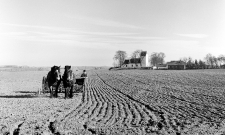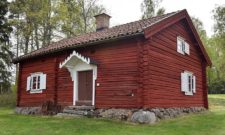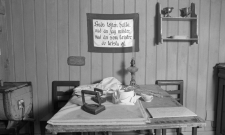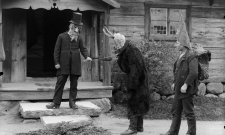Shop our historical maps

Christmas
"During his time as minister of ecclesiastics, Arthur Engberg wrote this article for the Society for the Preservation of Local History. It provides so many valuable and all still relevant comments that we cannot fail to give it publicity again." - Kulturhistoriska Verlaget, Swedish countryside and nature (1955)
In our museums, we see a large part of the history of mothers, their life in the weekend and in the parish. Here we can survey the advances in technology with which they sought to master a barren and unruly nature, be it the earth, the forest, the mountains or the sea. Here we can see the transition of the various ranks from the primitive to the complex machine culture of the present. Before our eyes, as it were, the style that characterises both man himself and his creations emerges, acquires firmness and stability.
It is the undeniable merit of our antiquity that it brings together the very factual basis of our cultural claims. It has been rightly demanded of historiography that it should give as faithful a picture as possible of the real life and work of the people. But the fulfilment of such claims presupposes, in the nature of things, a highly developed preservation of the past. It is no exaggeration to say that the most epoch-making contributions to classical research in recent times have been linked to and nourished by classical archaeology. Both the history of language and the history of religion have thus been thrown into new light. The study of Greek and Roman antiquities in general has been deepened and focused. Thanks to the achievements of classical antiquity, there has therefore been a revolution in the way we view the history of antiquity and the importance of classical languages. The same is true of the study of the history of our own people. Here, antiquity opens up unceasingly new perspectives and helps us to get closer to reality.
Is there not something great and liberating in the idea of making historical research a living concern of the whole people? For if it is true that the preservation of antiquities is a necessary part of this research, it is also true that the active collaborators are no longer just a handful of university men, but the whole host of men and women throughout the country whose unselfish interest in the locality, its memories and history, constitutes a source of power of the first order in the development of our provincial museums. This is the way in which antiquity is allowed to make research into the past the concern of the many, to bring it out into the countryside, to open the doors of the farms to it in an extraordinary way.
A landscape and its inhabitants are in spiritual interaction with each other. The concept of cultural landscape has been introduced. It means that the very external nature in which man lives, moves and has his being, is impressed by his creative spirit, is influenced in type and line play by his spirit. There can be no doubt that this is the case. Our provinces have been shaped not only by natural forces and geological processes, but also by ourselves. The spirit's style has blended into the landscape.
But conversely, the landscape itself has helped to shape people's creative minds. The intimate coexistence of man and nature over long ages has given his soul a peculiar colouring. The results of this interaction are to be found above all in the artistic style that characterises the work of her hands, a style that is perhaps more of an aim than a conclusion, more of a direction than a perfection. It is already apparent in the world of the first tools. It reveals itself in every new technical advance. It can be seen both in the building trade and in domestic handicrafts. In short, the artistic is there from the beginning. Archaeology and art history cannot therefore be separated. The thing cannot be separated from its form. What has emerged under the hands of craftsmen has not been shaped solely for practical purposes, but has also become an expression of the spirit's eternal need for beauty.

How did our fathers feel, think and aim? What visions seized them? Erik Gustaf Geijer speaks at one point of artists as revelators. Where science has fallen short, there they give the answer. Our Lord has - so Geijer thinks - placed in the path of humanity such helpers, who have been given the special gift of interpreting his intentions as in pictures. It is indeed grateful that they exist. We cannot do without them. For without them life would be empty and poor. It is not always that they themselves have been able to interpret their own visions. But when a soul, whose thoughts are as it were above it, so that it is surprised, is enraptured and suffers, when such a soul gives out of its wealth, something happens, something new comes into being. It is truly an act of creation. Genius is astonishing in its simplicity, its originality, its naivety. That is why genius is also childlike, immediate. For all art is a piece of the soul. The artist puts himself into his work, dictates himself into his creation, transfers his inner visions and experiences to it. But on the other hand, he also extracts features from reality, interprets, interprets and intercepts. He sneaks up on reality from within, surprises it, appropriates its hidden secret.

Our experience of the artwork is one of wonder at the richness of the creative spirit, its infinity and unpredictability. We sense there that the genius is the unreflected. It bursts forth as vision and revelation.
A museum is not a cemetery, not a dwelling of the dead. It is and wants to be a mediator between the past and the present. But more than that. It wants to be an educator, a helper, a guide for the people of the village in their quest to understand their own spiritual conditions. I need hardly emphasize how important it is, not least in our time, to counterbalance the degeneration and rootlessness which the rush of material technology undeniably brings. The home-grown movement seems to me to be a promising asset. A museum should be dedicated to deepening and broadening knowledge, to supporting and sustaining craftsmanship, to refining and enhancing taste, and to awakening interest in and love for the history and culture of the province. For our schools' teachers and pupils there are gratifying opportunities for valuable study visits. May I be permitted to wish that everything may be done to promote the intercourse of museums and schoolchildren. Thus we have our educational organizations and non-profit movements. They have every reason to make themselves the faithful guardians of museums and their well understood interests. Much good can be expected from such a living interaction between the people of the province and the museum.
Our Swedish provincial museums are already an impressive part of the country's cultural institutions. Thanks to understanding and sacrifice on the part of both the public and individuals, we have achieved beautiful results. But much remains to be done. The first and most important thing in all archaeological preservation is to know and care for the actual stock of archaeological remains in time. Here, in many cases, there can be danger in delay. Not only time itself, but also human negligence is wasting irreplaceable values. I am thinking here primarily of the condition of buildings, but also of other things that happen to get in the way of practical use. Taking stock of the actual stock, preserving it appropriately and protecting it from decay and destruction is probably an urgent task. In a country as vast as ours, however, this task is particularly demanding. It requires much careful supervision, diligent reconnaissance and effective intelligence. But it also, of course, places great demands on the insight and judgement of the fieldwork's targets. The greater the understanding in the community itself of the importance and value of heritage conservation, the easier it is to overcome the difficulties. And here the provincial museums have the great mission of awakening and increasing the interest of the people in their districts, and to the extent that they are able to carry it out, they contribute effectively to the success of the rescue and conservation work.
Strolling through the halls of the museums is tantamount to experiencing our Swedish culture, as it has been shaped and is shaped at different stages and in different areas. It provides a magnificent picture of work and artistry. To my mind's eye, they stand out, these myriad generations who have imprinted their work with their spirit. In different districts they have done their work and met good and bad days. I see them in their harshness and their striving, in their pride and their ardour, in their pride and their boldness. But I also see them in their tenderness and weakness, their humour and melancholy, their fabulism and playful imagination, great children, restless souls, where dew and shadow alternate, children of the sun and summer, but also of darkness and frost. Thus a museum was filled with life. The objects gain voice and speaking tongue. From the pomp of the mansion, the household utensils of the cottage and the shepherds, the countless tools of work and the exquisite creations of the home craftsman, our own genius meets us.
Subscribe to YouTube:
If you appreciate Allmogens independent work to portray our fine Swedish history and Nordic culture, you are welcome to buy something nice in the shop or support us with a voluntary donation. Thank you in advance!
Support Allmogens via Swish: 123 258 97 29
Support Allmogens by becoming a member
Support Allmogens in your will








